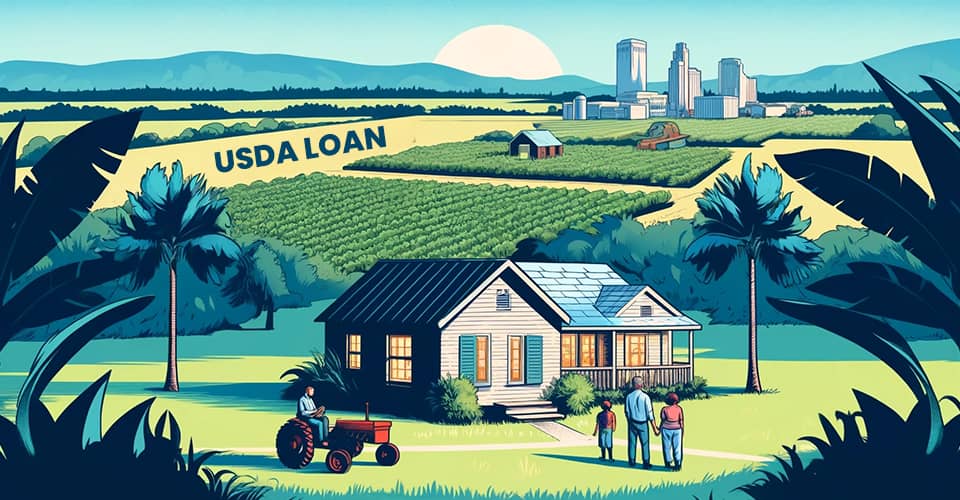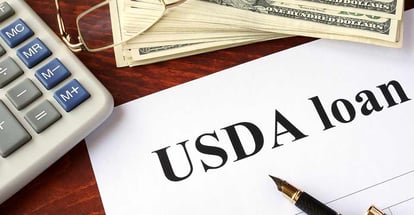What is a USDA Loan - For Florida Homebuyers
A USDA loan is a government-backed, no-money-down mortgage specifically designed for buyers and homes in less-dense parts of the country, including rural and suburban areas in Florida.
If you're considering buying a home outside of urban areas, the USDA's home loan program can offer you several advantages, including lower interest rates and payments compared to other government-backed programs such as FHA and VA.
In Florida, the USDA stands for the United States Department of Agriculture, an agency renowned for its involvement in farming, forestry, and food-related initiatives.
However, it also contributes to promoting home affordability and fostering strong communities in rural and suburban regions.
To determine if a property is eligible for a USDA loan, you can refer to the USDA Eligibility Map. Surprisingly, 91 percent of the United States, including various parts of Florida, falls within the USDA boundary.
This means that if you're a first-time home buyer looking to purchase a home outside of urban areas in Florida, utilizing the USDA's home loan program can be a viable option.
In this article, we'll cover everything first-time home buyers in Florida need to know about USDA loans.
How Does a USDA Loan Work?
USDA loans in Florida are distinct because they are guaranteed by the U.S. Department of Agriculture, reducing the risk for mortgage lenders and allowing them to offer lower interest rates. These loans have no prepayment penalties, allowing borrowers to pay off their loans early without extra fees.
Due to the USDA guarantee, these loans often have interest rates up to 0.50 percentage points lower than other low-down-payment options like HomeReady, HomePossible, and Conventional 97, even lower than VA mortgages, providing significant cost savings for homebuyers.
MakeFloridaYourHome offers USDA mortgages to eligible buyers.

How Does The USDA Define Rural?
The definition of "rural" for USDA loans in Florida is derived from Section 520 of the Housing Act of 1949.
Communities not meeting these rural criteria are classified as "urban." It's important to note that no specific government definition exists for suburbs or exurbs. Therefore, all United States homes are categorized as rural or urban.
In 2020, the Census Bureau introduced additional criteria to distinguish between rural and urban areas at the level of census tracts. A rural census tract is defined as meeting the following conditions:
-
It has fewer than 2,000 housing units or 5,000 people.
-
It has fewer than 500 residents per square mile.
-
It has no more than 425 housing units per square mile.
- It is not within a half-mile radius of an airport with an annual passenger count of 2,500 or more.
Homes in rural communities or census tracts that meet these criteria are eligible for USDA mortgages in Florida.
USDA Eligibility Map
You can use this USDA eligibility map to find an address and determine whether a home currently meets the USDA's property eligibility requirements.
Using the USDA map, you can quickly determine whether a house you want to buy might be eligible for the program. The areas eligible for properties can change yearly and are determined by the population density and other factors.
A USDA-approved lender like MakeFloridaYourHome can verify the eligibility of all the properties you want. To avoid wasting your time on properties that might not be eligible, it is best to contact a USDA-approved lender to confirm your address for a USDA loan.
How Do You Qualify for a USDA Loan?
Potential home buyers must meet specific criteria regarding property location and income to qualify for a USDA loan in Florida. Additionally, they must satisfy other standard mortgage qualifications.
Here are the eligibility requirements:
Property Location
The home purchased must be in a rural census tract defined by the USDA. The property's eligibility can be confirmed using the USDA website or consulting your mortgage lender.
Income Eligibility
Home buyers must have a household income within the USDA's specified low to moderate income limits for their area. These limits are available on the USDA website or can be obtained through a discussion with MakeFloridaYourHome.
Financial History
Applicants are expected to demonstrate a consistent history of on-time bill payments, indicating their ability to manage financial responsibilities effectively.
Citizenship or Residency
To qualify for a USDA loan, Home buyers must be U.S. citizens or permanent resident aliens.
Homeownership Education
Completing a certified homeownership education course is mandatory. This course can be taken online or in person to ensure buyers understand the responsibilities and requirements of owning a home.
Furthermore, it's important to understand that USDA loans are intended for modest primary residences. These loans are not available for vacation homes, rental properties, or commercial purposes like using the property for a business or retail store.
USDA mortgages in Florida are exclusively offered as 30-year fixed-rate mortgages. Adjustable-rate USDA mortgages are not available under this program.
USDA Loan Types & Variations
The USDA offers three primary mortgage programs to support home buyers in Florida - Guaranteed Loans, Direct Loans, and Home Repair Loans. Among these, the Guaranteed Loan program is the most commonly utilized by first-time home buyers.
Here's an overview of each program:
USDA Guaranteed Loan Program
The USDA Guaranteed Loan program, officially known as the Section 502 Single Family Housing Guaranteed Loan Program, accounts for 90 percent of annual USDA loans.
This program allows for 100% financing without needing mortgage insurance, making it an attractive option for buyers. Additionally, it enables buyers to attend the closing without any upfront payment requirements.
USDA Guaranteed Loans can be obtained through various channels, such as mortgage lenders, brokers, and retail banks. To qualify for these loans, a credit score of 640 or higher is generally required.
USDA Direct Loan Program
The Section 502 Single Family Housing Direct Loan Program is less common and more restrictive than other USDA housing programs, representing only about four percent of recent USDA loans.
Direct Loans are issued directly by the USDA, bypassing traditional lenders or banks. They are specifically designed for low—and very-low-income households who may face challenges getting approved for mortgages elsewhere.
The government subsidizes interest rates for Direct Loans, which stand at 5.125 percent as of April 29th, 2024. Direct Loan terms can extend up to 38 years, resulting in lower monthly payments.
Borrowers participating in this program often engage in ongoing credit counseling as a requirement for mortgage approval.
USDA Home Repair Loan Program
The USDA Section 504 Home Repair program offers loans of up to $40,000 to assist elderly, disabled, and low-income homeowners in maintaining the safety and livability of their homes.
These loans have a fixed interest rate of 1% and a repayment term of 20 years. It's important to note that the Home Repair Loan Program is exclusively available to existing homeowners seeking assistance with repairs and improvements.
These USDA mortgage programs provide valuable support to different population segments, ranging from first-time home buyers to those needing home repairs.
USDA Loan Unique Benefits
One notable benefit of USDA loans in Florida is that they do not require a down payment. The USDA mortgage program allows for 100% financing, enabling home buyers to purchase a home without making an upfront payment.
Additionally, USDA mortgage rates are typically extremely low compared to rates offered for similar low- and no-down-payment loans such as HomeReady, Home Possible, and VA mortgage loans for active-duty military personnel and veterans.
Another advantage is that USDA loans do not require mortgage insurance, which can significantly impact the overall cost of the loan.
Unlike conventional loans that often require a 20% down payment or mortgage insurance, the USDA charges a one-time guarantee fee of 1% at closing and an additional annual fee of 0.35%, resulting in potential cost savings for borrowers.
Home buyers utilizing USDA loans can purchase a home with $0 out of pocket. USDA guidelines allow buyers to include the guarantee fee, closing costs, and loan fees in the loan amount, even exceeding 100% of the home's purchase price.
Seller concessions are also permitted, reducing the cash required to close the transaction.
One valuable feature of USDA mortgages is their assumable nature. When homeowners decide to sell their property, the buyer can assume their existing USDA loan, maintaining the same interest rate and loan terms.
Assumable mortgages can increase a home's resale value, particularly when interest rates rise, as the buyer benefits from locked-in, lower mortgage rates.
The USDA Streamline Refinance program offers an automated rate reduction option for existing USDA mortgage holders.
Homeowners who have made timely mortgage payments for the past 12 months can qualify for this program, provided the refinance results in a monthly savings of $50 or more.
The USDA Streamline Refinance does not require employment verification or a home appraisal, making it a convenient option for eligible homeowners.
In summary, USDA loans in Florida provide several advantages, including no down payment requirement, low mortgage rates, no mortgage insurance, the ability to purchase a home with $0 out of pocket, assumability, and access to the streamlined refinancing program.
USDA Mortgage Statistics
The rural areas of the United States encompass a significant portion of the country's landmass and are eligible for 100% financing through the USDA Section 502 program.
Here are some insights and statistics related to rural populations and USDA Guaranteed Loans:
-
Approximately 56.3% of USDA homeowners are single or not married.
-
The average age of a USDA mortgage borrower is 37 years.
-
The average household income for USDA homeowners is $52,478.
-
The typical household size for USDA homeowners is 2.3 people.
-
The average size of a home financed by a USDA mortgage is approximately 1,445 square feet.
-
The average loan size for USDA mortgages is $127,406.
-
On average, USDA home buyers make a down payment of 2.12%.
-
According to USDA classification, 72.6% of USDA home buyers fall into the moderate-income category, while 25.6% are classified as low—or very-low-income earners.
- The USDA reports that 82.0% of USDA home buyers are first-time home buyers.
What’s the Difference Between USDA and FHA Loans?
USDA and FHA-backed loans are popular low-down-payment loan options available to first-time home buyers, as they are backed by government agencies and offer protection to mortgage lenders.
However, there are several differences between USDA and FHA loans, including down payment, income, and credit score requirements.
Here are some key distinctions:
Down payment
USDA mortgages allow home buyers to put less money down than FHA loans. USDA loans offer 100% financing, meaning no down payment is required, while FHA loans typically require a minimum down payment of 3.5%.
Upfront and ongoing fees
USDA mortgages generally have fewer upfront and ongoing fees than FHA loans. USDA loans have a one-time guarantee fee at closing and an additional annual fee, whereas FHA loans have upfront mortgage insurance premiums (MIP) and ongoing monthly mortgage insurance.
Property limitations
USDA mortgages are limited to one-unit homes, meaning they can only be used for single-family residences. On the other hand, FHA loans allow for a wider range of property types, including multi-unit homes (up to four units), as long as one of the units serves as the borrower's primary residence.
It's important to note that USDA and FHA loans are intended for primary residences only and cannot be used for vacation homes or rental properties.
These are some of the key differences between USDA and FHA loans.
You should consult with MakeFloridaYourHome to determine the specific requirements and eligibility criteria for each loan program based on your circumstances.
With over 50 years of mortgage industry experience, we are here to help you achieve the American dream of owning a home. We strive to provide the best education before, during, and after you buy a home. Our advice is based on experience with Phil Ganz and Team closing over One billion dollars and helping countless families.

About Author - Phil Ganz
Phil Ganz has over 20+ years of experience in the residential financing space. With over a billion dollars of funded loans, Phil helps homebuyers configure the perfect mortgage plan. Whether it's your first home, a complex multiple-property purchase, or anything in between, Phil has the experience to help you achieve your goals.


 By
By  Edited by
Edited by 




